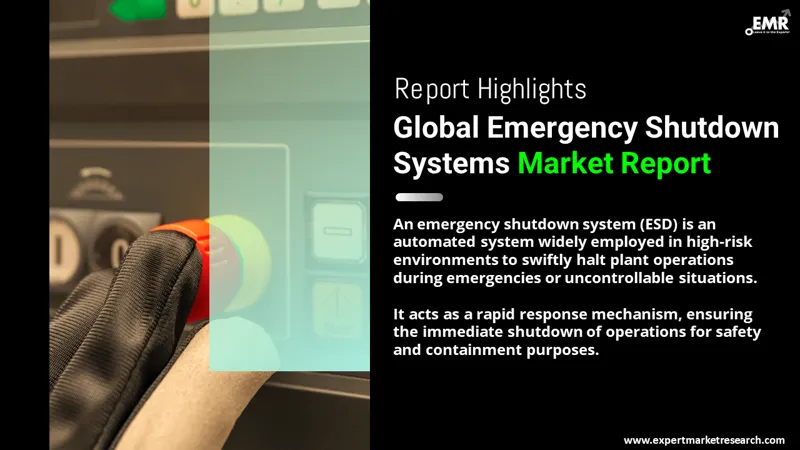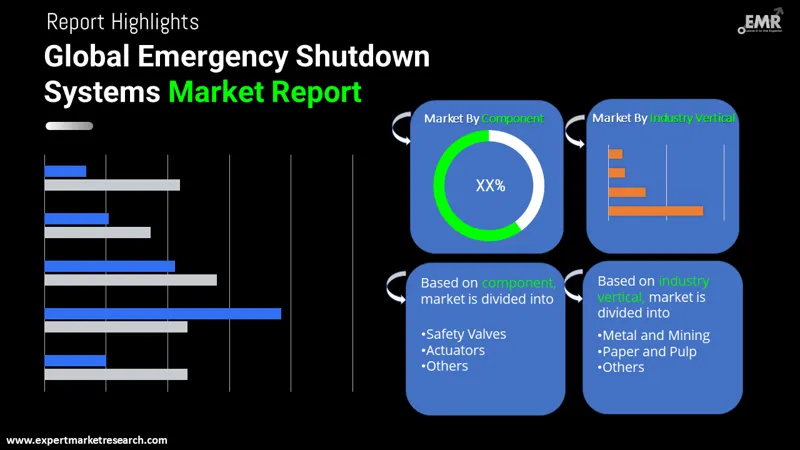
Consumer Insights
Uncover trends and behaviors shaping consumer choices today
Procurement Insights
Optimize your sourcing strategy with key market data
Industry Stats
Stay ahead with the latest trends and market analysis.
The global emergency shutdown systems market size reached a value of approximately USD 2.52 Billion in 2025. The market is expected to grow at a CAGR of 9.40% between 2026 and 2035, reaching a value of USD 6.19 Billion by 2035.
Base Year
Historical Period
Forecast Period
Compound Annual Growth Rate
9.4%
Value in USD Billion
2026-2035
*this image is indicative*
| Global Emergency Shutdown Systems Market Report Summary | Description | Value |
| Base Year | USD Billion | 2025 |
| Historical Period | USD Billion | 2019-2025 |
| Forecast Period | USD Billion | 2026-2035 |
| Market Size 2025 | USD Billion | 2.52 |
| Market Size 2035 | USD Billion | 6.19 |
| CAGR 2019-2025 | Percentage | XX% |
| CAGR 2026-2035 | Percentage | 9.40% |
| CAGR 2026-2035 - Market by Region | Latin America | 9.9% |
| CAGR 2026-2035 - Market by Country | China | 9.8% |
| CAGR 2026-2035 - Market by Country | Mexico | 9.7% |
| CAGR 2026-2035 - Market by Component | Programmable Safety Systems | 10.2% |
| CAGR 2026-2035 - Market by Industry Vertical | Oil and Gas | 10.4% |
| Market Share by Country 2025 | UK | 3.7% |
An emergency shutdown system or ESD system is an automatic system that is commonly used in potentially hazardous areas that immediately shuts down operations of a plant in case of emergencies or uncontrolled situations. It is designed to protect the area from catastrophic impacts on the environment, operations, people, and finances.

Read more about this report - REQUEST FREE SAMPLE COPY IN PDF
Global Emergency Shutdown Systems Market Report and Forecast 2026-2035 offers a detailed analysis of the market based on the following segments:
Breakup by Component
Breakup by Industry Vertical
Breakup by Region
| CAGR 2026-2035 - Market by | Country |
| China | 9.8% |
| Mexico | 9.7% |
| USA | 9.6% |
| UK | 9.5% |
| Saudi Arabia | 9.1% |
| Canada | XX% |
| Germany | 8.6% |
| Italy | XX% |
| Japan | XX% |
| India | XX% |
| Australia | XX% |
| Brazil | XX% |
| France | 8.2% |

Read more about this report - REQUEST FREE SAMPLE COPY IN PDF
Oil and gas accounts for a sizable share of the market for emergency shutdown systems based on industry vertical owing to increasing production capacities to meet the rising demands for end-use products. The high level of risks involved in oil and gas operations is resulting in an increased demand for emergency shutdown systems to prevent accidents. Emergency shutdown systems aid in protecting equipment and supporting uninterrupted operations, thereby reducing the financial risk of oil and gas companies.
Europe occupies a significant share of the emergency shutdown systems market owing to the high industrial activity in the region which is supported by the presence of large crude oil refiners. Various end use industries in the region are adopting emergency shutdown systems with industrial control systems that have advanced technologies. This is subjected to further increase the demand for emergency shutdown systems in large, small and medium-sized enterprises across Europe.
The comprehensive EMR report provides an in-depth assessment of the market based on the Porter's five forces model along with giving a SWOT analysis. The report gives a detailed analysis of the following key players in the global emergency shutdown systems market, covering their competitive landscape and latest developments like mergers, acquisitions, investments and expansion plans.
General Electric Co. was founded in 1892 and is headquartered in Massachusetts, United States. It is a multinational company that operates in power, digital industry, aviation, renewable energy, venture capital and finance, and additive manufacturing, among others.
Siemens AG is a multinational automation company that was founded in 1847 and is headquartered in Munich, Germany. The company focuses on operating in areas such as electrification, digitalisation, and automation, among others.
Honeywell International Inc. was established in 1853 and has its headquarter located in North Carolina, United States. The company primarily focuses in four areas of business: technologies, aerospace, performance materials, and building technologies.
*Please note that this is only a partial list; the complete list of key players is available in the full report. Additionally, the list of key players can be customized to better suit your needs.*
Other market players include ABB Ltd, Schneider Electric SE, Emerson Electric Co., Yokogawa Electric Works Ltd., Rockwell Autonomation Inc., Winn-Marion Companies, and Versa Products Co., Inc., among others.




*While we strive to always give you current and accurate information, the numbers depicted on the website are indicative and may differ from the actual numbers in the main report. At Expert Market Research, we aim to bring you the latest insights and trends in the market. Using our analyses and forecasts, stakeholders can understand the market dynamics, navigate challenges, and capitalize on opportunities to make data-driven strategic decisions.*
Get in touch with us for a customized solution tailored to your unique requirements and save upto 35%!
The market reached a value of approximately USD 2.52 Billion in 2025.
The market is expected to grow at a CAGR of 9.40% between 2026 and 2035.
The market is estimated to witness a healthy growth in the forecast period of 2026-2035 to reach around USD 6.19 Billion by 2035.
The key drivers in the market are increasing importance of preventing catastrophic accidents, expansion of various production plants, and strict policies of various governments to reduce accidents in industries.
The key trends of the market include rising investments towards the installation of emergency shutdown systems, increasing demands from the oil and gas industries, and technological advancements.
The major regions in the market are North America, Europe, Asia Pacific, Latin America, and the Middle East and Africa.
The various components of emergency shutdown systems include switches, sensors, programmable safety systems, safety valves, and actuators, among others.
The emergency shutdown systems market key players are General Electric Co, Siemens AG, Honeywell International Inc, ABB Ltd, Schneider Electric SE, Emerson Electric Co., Yokogawa Electric Works Ltd., Rockwell Autonomation Inc., Winn-Marion Companies, and Versa Products Co., Inc., among others.
Explore our key highlights of the report and gain a concise overview of key findings, trends, and actionable insights that will empower your strategic decisions.
| REPORT FEATURES | DETAILS |
| Base Year | 2025 |
| Historical Period | 2019-2025 |
| Forecast Period | 2026-2035 |
| Scope of the Report |
Historical and Forecast Trends, Industry Drivers and Constraints, Historical and Forecast Market Analysis by Segment:
|
| Breakup by Component |
|
| Breakup by Industry Vertical |
|
| Breakup by Region |
|
| Market Dynamics |
|
| Competitive Landscape |
|
| Companies Covered |
|
Single User License
One User
USD 3,999
USD 3,599
tax inclusive*
Datasheet
One User
USD 2,499
USD 2,249
tax inclusive*
Five User License
Five User
USD 4,999
USD 4,249
tax inclusive*
Corporate License
Unlimited Users
USD 5,999
USD 5,099
tax inclusive*
*Please note that the prices mentioned below are starting prices for each bundle type. Kindly contact our team for further details.*
Flash Bundle
Small Business Bundle
Growth Bundle
Enterprise Bundle
*Please note that the prices mentioned below are starting prices for each bundle type. Kindly contact our team for further details.*
Flash Bundle
Number of Reports: 3
20%
tax inclusive*
Small Business Bundle
Number of Reports: 5
25%
tax inclusive*
Growth Bundle
Number of Reports: 8
30%
tax inclusive*
Enterprise Bundle
Number of Reports: 10
35%
tax inclusive*
How To Order

Select License Type
Choose the right license for your needs and access rights.

Click on ‘Buy Now’
Add the report to your cart with one click and proceed to register.

Select Mode of Payment
Choose a payment option for a secure checkout. You will be redirected accordingly.
Gain insights to stay ahead and seize opportunities.

Get insights & trends for a competitive edge.

Track prices with detailed trend reports.

Analyse trade data for supply chain insights.

Leverage cost reports for smart savings

Enhance supply chain with partnerships.

Connect For More Information
Our expert team of analysts will offer full support and resolve any queries regarding the report, before and after the purchase.
Our expert team of analysts will offer full support and resolve any queries regarding the report, before and after the purchase.
We employ meticulous research methods, blending advanced analytics and expert insights to deliver accurate, actionable industry intelligence, staying ahead of competitors.
Our skilled analysts offer unparalleled competitive advantage with detailed insights on current and emerging markets, ensuring your strategic edge.
We offer an in-depth yet simplified presentation of industry insights and analysis to meet your specific requirements effectively.
Share